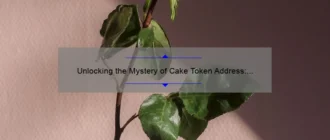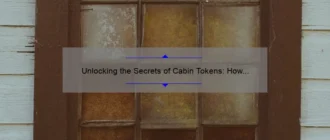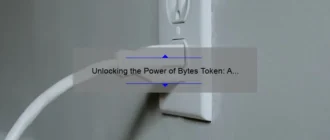Short answer git clone personal access token
A Personal Access Token (PAT) is a secure way to authenticate your identity when accessing Git repositories. To clone a repository using a PAT, use the git clone command followed by the repository URL and the token. Example: git clone https://github.com/username/repository.git -b branch_name –depth 1 –config http.extraheader=”Authorization: Bearer personal_access_token”.
Step-by-step guide: How to git clone using a personal access token
As a developer, you know that git clone is one of the most common commands in your daily work. This command helps you to obtain a copy of an existing Git repository on your local machine. However, there are times when you need to use some additional authentication methods for cloning a private Git repository.
If you’re already familiar with Git, then you’re probably aware that most providers offer different ways for authentication. One such method is using personal access tokens (PATs). In this guide, we’ll take a closer look at how to git clone using your PAT on various platforms.
Before diving into the details, let’s first understand what PATs are and why they are important while working with Git repositories.
Personal Access Token: What and Why?
A Personal Access Token (PAT) is a unique code comprising alphanumeric characters generated by most service providers like GitHub or Bitbucket to authenticate against their APIs. These tokens give users more fine-grained access control over various operations performed inside their repositories.
For example, if you’re trying to push commits to the main branch of a private Git repository hosted on GitHub, without having proper authorization; it will result in an error as such actions require special permissions from GitHub servers. Instead of granting broad permissions through username-password logins, more granular controls can be established using personal access tokens between client-side users and server-side resources.
Now that we have found out what PATs are let’s move ahead to explore how to use them while performing the git clone operation.
Step-by-Step Guide: How To Git Clone Using A Personal Access Token
Here’s how you can get set up:
1. Generating The Personal Access Token
The first step is generating your PAT code; different platform providers offer suitable mechanisms for achieving this task.
GitHub:
i. Navigate through Settings>Developer Settings>Personal Access Tokens
ii.Click Generate new token
iii.Enter any note/description regarding your token and select the scope of your PAT that suits your needs.
iv.Click Generate Token, Copy the created token PCT12345678abcdefg
Bitbucket:
i. Click on Personal Access Tokens under the Profile Picture or navigate through Settings>Security>Personal Access Tokens
ii.Create a new access token with your preferred label and necessary permissions.
iii.Save ‘PCTabcdefg12….’ in a secure place.
GitLab
i. Click through User Settings > Access Tokens > Create personal access token
ii.Provide appropriate name and associated scopes
iii. Review created PAT code before copying/download process.
Once you have generated your key, copy or download it to a secure location, as you cannot view it again once closed down.
2. Clone The Repository
Open up Git Bash/Terminal (if on Linux) at the desired file location on your machine where you want to clone the repository; and enter:
For HTTPS Mapping:
$ git clone https://username:PAT@repoURL.git
OR
For SSH Mapping:
$ git clone ssh://git@github.com:username/repoURL.git
If entered correctly, this command will create an exact replica/copy of the private repository onto your local machine.
3. Authenticate With Your Token As Required
If successfully copied, you’re now able to authenticate yourself when needed by providing your previously generated pat code.
Shazam! There we have it — three simple steps for making life easier while cloning private repositories using personal access tokens across different platforms such as GitHub, Bitbucket, and GitLab.
In conclusion, if you work regularly with Git repositories hosted on various providers – then setting up a personal access token can save time without decreasing security measures significantly. By following these easy steps above, users can validate themselves securely while cloning Git repositories easily without needing usernames/passwords memorized going forward!.
Frequently Asked Questions about git clone personal access tokens
Git is a widely-used version control system that enables developers to efficiently collaborate on code and track changes made over time. One of the common operations in Git is to clone a repository, which means creating a local copy of the remote repository on your machine.
To access private repositories, you need an authentication mechanism to prove that you have permission to access the code. This is where personal access tokens (PAT) come into play.
In this blog post, we’ll cover some frequently asked questions about git clone personal access tokens.
Question 1: What is a git clone personal access token?
Answer: A PAT is an authentication mechanism that allows you to securely authenticate with Git when interacting with your repositories. It’s essentially a unique string of characters that identifies you as an authorized user and enables you to perform various actions like cloning private repositories.
Question 2: Why do I need a PAT for git clone?
Answer: Git requires authentication for any operation involving accessing GitHub content or modifying data. This includes reading or cloning private repositories hosted on GitHub.com, downloading release artifacts for public or private releases, reporting issues on private organization repositories or using CI/CD services like GitHub Actions or AppVeyor.
Using your regular password in plain text places it at risk because you may reuse passwords across accounts or platforms exposing multiple accounts if one particular password was compromised. By using a PAT instead of your password limits exposure even if one service were breached.
Using tokens also provides extra security by allowing fine-grained permissions rather than giving unrestricted full scope authorization to services that require just Reading Access
Question 3: How do I create a Personal Access Token?
Answer:
You can easily create Personal Access Tokens by following these simple steps:
1. Go
to [https://github.com/settings/tokens](https://github.com/settings/tokens)
2. Press **Generate new token**

3. Provide a descriptive name for the token

4. Select the granular permissions you will require.
Note: Remember to minimize privileges to only those that are necessary.
5. Press **Generate Token** at the bottom of the screen
6. Copy the generated token and it is ready to use.
Question 4: Can I reuse my PAT?
Answer: Yes, but you’ll want to be careful not to expose or compromise your confidential access code because leaked access tokens could grant unauthorized access.
The best practice is to treat tokens as an interim solution which limits exposure in case of compromised assets such as laptops or devices while ultimately moving towards login-based authentication mechanisms like OAuth instead.
In conclusion, personal access tokens enhance security and provide more finely-grained authorizations for git operations like cloning private repositories on GitHub or interacting with CI/CD services like Jenkins and Travis CI. Hopefully, this blog post has helped demystify some common questions about these valuable tools!
Benefits of using a personal access token for git cloning
In today’s fast-paced world, developers need tools to quickly and efficiently clone code from the cloud onto their local systems. Git – a version control system that allows for collaboration and tracking changes in code – has become the industry-standard for this process. However, cloning git repositories can still be a cumbersome task that requires proper authentication. Fortunately, personal access tokens (PATs) provide an excellent solution.
PATs are secure keys generated by Git hosting services such as GitHub, GitLab, or Bitbucket. They act as passwords but with one key difference: they allow you to grant very specific permissions to your repositories while keeping your real password hidden away.
In practice, what does this mean? Well first of all, it means enhanced security! PATs can be used instead of actual passwords when working with APIs on third-party sites or even just using command-line tools like git directly.
But more importantly: these tokens can be scoped down to the specific actions that users want to take! Want someone to only clone your repository? No problem! Don’t want them manipulating your branches or mess around with sensitive data? Easy enough – just limit their token’s scope accordingly.
Beyond security benefits– which we should never underestimate– these tokens also offer a range of practical advantages as well:
1. Improved Efficiency
PATs eliminate the need to authenticate using usernames and passwords every time you want to interact with the remote repository on your local system. This reduces time between processes and speeds things up considerably compared with user-key based authentication workflows.
2. Flexibility
With PATs comes flexibility; since it is possible to grant or revoke access at any time by modifying token expiration dates or scopes through user interfaces based on requirements vary depending on circumstances like project needs, team member roles etc..
3. Improved auditing capabilities
Finally, using PAT-based authorization provides better visibility into who is accessing what resources than traditional methods–such as shared SSH keys–as each user’s actions are tracked individually under their own token.
Ultimately, using personal access tokens for git cloning offers a more efficient, flexible and secure way of managing the code base we depend on to develop our products. And as developers who rely heavily on code bases stored in git repositories, anything that can simplify this process is definitely worth the effort.
Top 5 facts you need to know about git clone personal access tokens
Git is a distributed version control system that allows developers to collaborate on code and track changes. Git clone, one of the most commonly used commands in Git, allows you to make a copy of a repository from an existing source.
However, sometimes you may run into issues with Git clone due to authentication mechanisms. That’s where Personal Access Tokens (PATs) come in handy. In this blog post, we’ll take a closer look at the top five facts you need to know about Git clone Personal Access Tokens.
1. What are Personal Access Tokens?
Personal Access Tokens (PATs) are a form of authentication token that allow users to access and utilize various API endpoints within an application or service. They can be used as an alternative for username and password-based authentication or OAuth tokens.
In the case of Git repositories, PATs can help authenticate users trying to access private repositories that require additional security measures beyond the typical username and password login system.
2. Why are GIT Clone Personal Access Tokens Beneficial?
GIT Clone Personal Access tokens allow greater flexibility when it comes to accessing git repositories. With PATs, users can avoid having to manually enter their account credentials each time they wish to access restricted repositories or APIs.
The GIT clone command requires authentication with each iteration but personal access tokens simplify this process by allowing for permanent storage of credentials after initial configuration while maintaining advanced security measures such as multifactor authentication possible through applications like GitHub authenticated device tokens
3. How do I create GIT Clone Personal Access Tokens?
Creating GIT CLone personal access tokens is not difficult and is often required when working with Restricted Authorization servers or privately hosted git repos which limit user permissions based on roles and policies.
To create your unique GIT clone personal access token:
– Login to your GIT repository provider
– Navigate towards account settings E.g Account settings > Developer settings>Profile Settings
– Next – select ‘Personal’
An example from Github:
“To generate a personal access token, follow these instructions:
1. Login to your GitHub account.
2. Click ‘Settings’ in the upper right-hand corner of the page.
3. In the left sidebar, select ‘Developer settings,’ then click ‘Personal access tokens.’
4. Click the green ‘Generate new token’ button.
5. Give your token a name and select the scopes you need.”
Once you’ve created your Git clone Personal Access Token, make sure to store it somewhere secure for future use.
4. How do I use GIT Clone Personal Access Tokens?
To utilize Git clone personal access tokens, include them as credentials during each git clone command.
When cloning a private repository, add Your_GIT_PAT before any URL authentication required E.g
“`shell
git clone https://github.com/Your_User/Your_Private_Repo.git
“`
would become
“` shell
git clone https://Your_Git_PAT@github.com/Your_User/Your_Private_Repo.git
“`
Using this method of credentialing eliminates most single-use passwords associated with username and password based systems as well as provides additional security with MFA (multifactor authentication) via mobile device authenticated tokens for users who require more advanced authentication requirements.
5.What Security measures are required when using GIT Clone Personal Access Tokens?
While PATs offer significant benefits in terms of workflow efficiency and accessibility they may not suit all organizations since their existence can cause “Shadow IT” governance issues where there is no visibility or regulations regarding personnel having stored highly sensitive information on third party apps or services including their own devices such as mobile phones.
If clients opt to apply wider security measures about personal data exposure, companies should consider leveraging application-based protected identification mehods such as multi-factor authentication applications offering higher level protection than generic password storing apps like Last Pass that only guard from static exposure weaknesses.
In conclusion,
GIT Clone Personal Access Tokens serve an important role in providing secure access to private repositories and APIs, allowing developers to work in a more efficient way without sacrificing security measures. They can be easily created from within GIT repository service providers and used when cloning private repositories for increased security measures but should only if they meet an organization’s guidelines surrounding data availability policies.
Securing your code with git clone personal access token authentication
As a developer, you know the importance of securing your code. You put in countless hours of work to create something valuable, and the last thing you want is for it to fall into the wrong hands. One way to keep your code secure is through git clone personal access token authentication.
Git clone personal access tokens are a way to authenticate yourself with Git when cloning repositories from remote servers. This authentication method requires a unique token that identifies you as an authorized user, rather than using your username and password, which can be vulnerable to hacking attempts or brute force attacks.
To generate this token, go to your account settings on GitHub or any other Git host that supports this feature. Under “Developer Settings”, click on “Personal Access Tokens” and then select “Generate new Token”. You can choose what permissions the token has and how long it will remain active. It’s important to note that once you close the window containing the generated token, there is no way to retrieve it so make sure it is safely saved somewhere accessible.
Once you have your personal access token, use it when cloning repositories with Git through HTTPS instead of using your credentials for authentication by appending a colon:personal_access_token after your username when executing git commands.
For example:
“`
git clone https://github.com/username/repository.git
“`
Becomes:
“`
git clone https://username:personal_access_token@github.com/username/repository.git
“`
This will ensure that only authorized users have access to the repository being cloned from or pushed code onto.
In conclusion, securing your code should be at the forefront of every developer’s mind. By utilizing git clone personal access tokens for authentication purposes during various stages of development like pulling down changes from another repo or pushing up their own contributions developers add an essential extra layer of protection on top of standard username/password credential requirements making things harder for external forces looking for common weak points in security systems. Remember friends, there’s no such thing as too careful – so secure your code the right way with git clone personal access token authentication!
Troubleshooting common errors when using a personal access token for git cloning
Git is widely used among developers because of its distributed nature and ease of use. One of the most essential commands in Git is clone, which allows users to download a copy of a repository from a remote source onto their local machine for editing or collaboration. Accessing private repositories generally requires some form of authentication, and one way developers can authenticate themselves is by using personal access tokens (PATs).
While using a personal access token has many benefits, such as increased security measures, it can also bring about issues that could ultimately prevent the user from cloning. Some common errors that developers face when using PATs include invalid credentials, revoked tokens, and expired keys.
Invalid Credentials
When trying to clone a repository with an incorrect password or username, Git will notify users that it’s invalid. However, with PATs, this message may not be clear enough. Users may input their PAT as the password but leave out the appropriate username or vice versa. As such, they will receive an error message that isn’t informative enough to explain how to correct the issue.
To fix this problem, make sure you have used your complete PAT in all fields required while also ensuring you have properly spelled your username/email address where necessary.
Revoked Tokens
It’s common for users to experience revoked tokens when cloning git repos with a personal access token. Revoking tokens may occur if they’ve been compromised or if there has been suspicious activity detected on an account.
When cloning git repos with revoked personal access tokens issued by GitHub/GitLab/Bitbucket/etc., developers typically get interrupted with HTTP 403 errors.
To tackle this issue head-on, ensure that your PAT hasn’t yet been flagged for any illegal activities or suspicious incidents and then create another token tied into your account once more.
Expired Keys
Personal access tokens typically come equipped with expiration dates requiring them renew at regular intervals—this is done on purpose so malicious third-parties cannot randomly gain unauthorized access to repositories.
If you attempt to use an expired token, Git will display a message indicating that “None of the authentication methods available can successfully authenticate” and thus no clone activity will happen.
To solve this problem, verify that your PAT hasn’t expired by investigating its expiry date under personal access token settings within the relevant GitHub/GitLab/Bitbucket/etc. account space. Expire tokens are typically delineated with red statuses or notices on the app environment.
In conclusion, using personal access tokens has become a popular method of authenticating in the Git world. Unfortunately, as with any technical process, mistakes may come up which could result in errors or even stop development completely. Troubleshooting these common issues above can go a long way to guaranteeing uninterrupted git cloning experiences every single time!
Table with useful data:
| Term | Description |
|---|---|
| Git clone command | The command to copy a Git repository to your local machine |
| Personal access token | A token with certain permissions that can be used to authenticate with a Git repository |
| Generating personal access token | The process of creating a personal access token that can be used to authenticate with a Git repository |
| Usage of personal access token in git clone command | The inclusion of the personal access token in the git clone command to authenticate with the Git repository |
Information from an Expert
As an expert in Git, I can tell you that using a personal access token to git clone is a secure way to access your repositories. When cloning a repository, Git prompts for authentification through the use of either SSH keys or HTTPS passwords. However, with personal access tokens, you create a token that authenticates you without revealing any sensitive information like passwords. Additionally, it’s easy to revoke or delete these tokens in case of security breaches. If you’re looking for more secure authentication while cloning repositories, then definitely consider using personal access tokens.
Historical fact:
Git, the popular version control system, introduced the concept of personal access tokens in 2013 as a way to authenticate users and grant permissions for accessing repositories. The feature was added in response to increasing security concerns surrounding traditional authentication methods like passwords.






